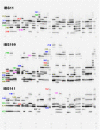Genetic Identity, Diversity, and Population Structure of CIP's Sweetpotato (I. batatas) Germplasm Collection
- PMID: 34777403
- PMCID: PMC8589021
- DOI: 10.3389/fpls.2021.660012
Genetic Identity, Diversity, and Population Structure of CIP's Sweetpotato (I. batatas) Germplasm Collection
Abstract
The in trust sweetpotato collection housed by the International Center of Potato (CIP) is one of the largest assemblages of plant material representing the genetic resources of this important staple crop. The collection currently contains almost 6,000 accessions of Ipomoea batatas (cultivated sweetpotato) and over 1,000 accessions of sweetpotato crop wild relatives (CWRs). In this study, the entire cultivated collection (5,979 accessions) was genotyped with a panel of 20 simple sequence repeat (SSR) markers to assess genetic identity, diversity, and population structure. Genotyping and phenotyping of in vitro plantlets and mother plants were conducted simultaneously on 2,711 accessions (45% of the total collection) to identify and correct possible genetic identity errors which could have occurred at any time over the thirty plus years of maintenance in the in vitro collection. Within this group, 533 accessions (19.6%) had errors in identity. Field evaluations of morphological descriptors were carried out to confirm the marker data. A phylogenetic tree was constructed to reveal the intraspecific relationships in the population which uncovered high levels of redundancy in material from Peru and Latin America. These genotypic data were supported by morphological data. Population structure analysis demonstrated support for four ancestral populations with many of the accessions having lower levels of gene flow from the other populations. This was especially true of germplasm derived from Peru, Ecuador, and Africa. The set of 20 SSR markers was subsequently utilized to examine a subset of 189 accessions from the USDA sweetpotato germplasm collection and to identify and reconcile potential errors in the identification of clones shared between these collections. Marker analysis demonstrated that the USDA subset of material had 65 unique accessions that were not found in the larger CIP collection. As far as the authors are aware, this is the first report of genotyping an entire sweetpotato germplasm collection in its entirety.
Keywords: SSRs; genebank; genetic diversity; genetic identity; germplasm; population structure; sweetpotato.
Copyright © 2021 Anglin, Robles, Rossel, Alagon, Panta, Jarret, Manrique and Ellis.
Conflict of interest statement
The authors declare that the research was conducted in the absence of any commercial or financial relationships that could be construed as a potential conflict of interest.
Figures






References
-
- Austin D. F. (1988). The taxonomy, evolution, and genetic diversity of sweetpotatoes and related wild species, in Exploration, Maintenance and Utilization of Sweetpotato Genetic Resources, ed Gregory P. (Lima: International Potato Center; ), 27–59.
-
- Bohac J., Austin D., Jones A. (1993). Discovery of wild tetraploid sweetpotatoes. Econ. Bot. 47, 193–201. 10.1007/BF02862022 - DOI
LinkOut - more resources
Full Text Sources
Research Materials

